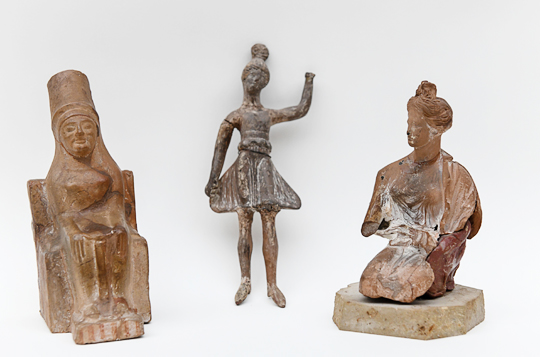A Goddess, a Dancer and a Daughter from the Best of Families
Freiburg, May 24, 2018
Things from days gone by often find their way into the University of Freiburg’s Archaeological Collection as gifts. Frequently, the donated pieces are valuable. A series has been dedicated to presenting the most beautiful and unusual new donations. This time: four clay statuettes of women.

The ancient statuettes will in future be exhibited in the display cases of the Archaeological Collection, where visitors will be able to get an impression of them. Photo: Patrick Seeger
They come from different regions and served different purposes. What they share is the material of which they are made. All four are terracotta, meaning they were modeled from clay that was then fired. They came to the Archaeological Collection in 2014 as a gift. “We only have a few clay figures. That’s why I didn’t hesitate for a second to accept the gift, for which I am very grateful to the donor,” says Dr. Jens-Arne Dickmann, Curator of the Archaeological Collection. The donor is a retired doctor. He did not collect the statuettes himself. Instead, they belonged to his family.
A symbolic sacrifice to a goddess
What is likely the oldest statuette is of a woman who is sitting on something resembling a throne. “She was made in the 6th century BC. I still need to check whether her origins are Ionian, which I suspect. Therefore, she would come from the coastal areas of western Asia Minor,” explains Dickmann. “Perhaps the figure represents a divine being. It could also be a votive offering to the goddess it depicts,” he adds. The bust of a woman in ceremonial garb is from a similar time period. “This piece may be from southern Italy. It’s possible that she also represents a divinity. Culturally, Greek colonization characterizes the figure,” continues Dickmann. She shows traces of severe damage and has several cracks. The missing pieces were only replaced in a makeshift way. The statuette of a dancer in a little skirt and with pinned-up hair probably dates back to the second or first century BC. Her left hand is missing and the right arm shows evidence of breakage. Dickmann supposes that the piece is of Myrinian origin. During the Hellenistic period terracotta statuettes like these were made in the town of Myrina on Asia Minor's northwestern coast. Archaeologists found similar statuettes later on in the town’s burial ground, the necropolis.
From a good family
The youngest statuette is the one that has been most visibly damaged. Dickmann says the figure of a young woman sitting dates back to the second or first century BC. He suspects that she was made in the eastern Mediterranean region. “It’s a very beautiful, high quality piece. The woman has a fine facial features and carefully modeled hairdo. Her garment has also been fashioned with great skill,” Dickmann says. The robe and gown underneath it – known as a chiton – lead the curator to surmise that it is likely a depiction of a city dweller and member of a well-situated family. “That would be very unusual garb for a goddess,” he explains. Unlike vessels, continues Dickmann, these items are not suitable for drawing exercises because archaeologists today barely have the skills or experience required. “Yet as tools for dating and determining origin, they’re great,” he explains. “Because there are just a few terracotta figures in our collection, they will be exhibited after the reorganization of the collection’s display cases that is currently underway. At least those pieces that don’t have to be restored first,” says the curator.
Hans-Dieter Fronz

